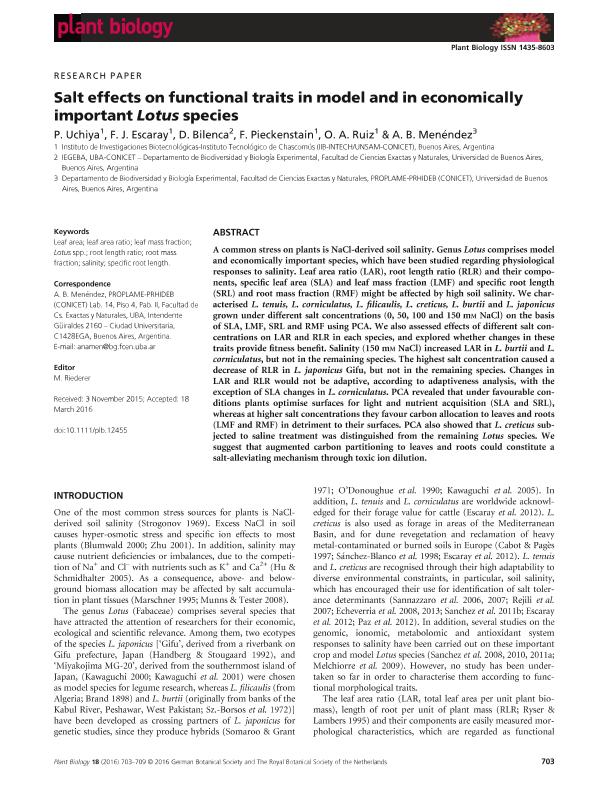Artículo
Salt effects on functional traits in model and in economically important Lotus species
Uchiya, Patricia Alejandra; Escaray, Francisco José ; Bilenca, David Norberto
; Bilenca, David Norberto ; Pieckenstain, Fernando Luis
; Pieckenstain, Fernando Luis ; Ruiz, Oscar Adolfo
; Ruiz, Oscar Adolfo ; Menendez, Ana Bernardina
; Menendez, Ana Bernardina
 ; Bilenca, David Norberto
; Bilenca, David Norberto ; Pieckenstain, Fernando Luis
; Pieckenstain, Fernando Luis ; Ruiz, Oscar Adolfo
; Ruiz, Oscar Adolfo ; Menendez, Ana Bernardina
; Menendez, Ana Bernardina
Fecha de publicación:
07/2016
Editorial:
Wiley Blackwell Publishing, Inc
Revista:
Plant Biology
ISSN:
1435-8603
Idioma:
Inglés
Tipo de recurso:
Artículo publicado
Clasificación temática:
Resumen
A common stress on plants is NaCl-derived soil salinity. Genus Lotus comprises model and economically important species, which have been studied regarding physiological responses to salinity. Leaf area ratio (LAR), root length ratio (RLR) and their components, specific leaf area (SLA) and leaf mass fraction (LMF) and specific root length (SRL) and root mass fraction (RMF) might be affected by high soil salinity. We characterised L. tenuis, L. corniculatus, L. filicaulis, L. creticus, L. burtii and L. japonicus grown under different salt concentrations (0, 50, 100 and 150 mm NaCl) on the basis of SLA, LMF, SRL and RMF using PCA. We also assessed effects of different salt concentrations on LAR and RLR in each species, and explored whether changes in these traits provide fitness benefit. Salinity (150 mm NaCl) increased LAR in L. burtii and L. corniculatus, but not in the remaining species. The highest salt concentration caused a decrease of RLR in L. japonicus Gifu, but not in the remaining species. Changes in LAR and RLR would not be adaptive, according to adaptiveness analysis, with the exception of SLA changes in L. corniculatus. PCA revealed that under favourable conditions plants optimise surfaces for light and nutrient acquisition (SLA and SRL), whereas at higher salt concentrations they favour carbon allocation to leaves and roots (LMF and RMF) in detriment to their surfaces. PCA also showed that L. creticus subjected to saline treatment was distinguished from the remaining Lotus species. We suggest that augmented carbon partitioning to leaves and roots could constitute a salt-alleviating mechanism through toxic ion dilution.
Archivos asociados
Licencia
Identificadores
Colecciones
Articulos(CCT - LA PLATA)
Articulos de CTRO.CIENTIFICO TECNOL.CONICET - LA PLATA
Articulos de CTRO.CIENTIFICO TECNOL.CONICET - LA PLATA
Articulos(IEGEBA)
Articulos de INSTITUTO DE ECOLOGIA, GENETICA Y EVOLUCION DE BS. AS
Articulos de INSTITUTO DE ECOLOGIA, GENETICA Y EVOLUCION DE BS. AS
Articulos(IIB-INTECH)
Articulos de INST.DE INVEST.BIOTECNOLOGICAS - INSTITUTO TECNOLOGICO CHASCOMUS
Articulos de INST.DE INVEST.BIOTECNOLOGICAS - INSTITUTO TECNOLOGICO CHASCOMUS
Articulos(SEDE CENTRAL)
Articulos de SEDE CENTRAL
Articulos de SEDE CENTRAL
Citación
Uchiya, Patricia Alejandra; Escaray, Francisco José; Bilenca, David Norberto; Pieckenstain, Fernando Luis; Ruiz, Oscar Adolfo; et al.; Salt effects on functional traits in model and in economically important Lotus species; Wiley Blackwell Publishing, Inc; Plant Biology; 18; 4; 7-2016; 703-709
Compartir
Altmétricas



